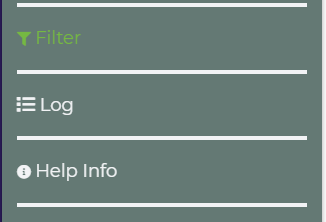Filters are used to locate items in a list. The Filters settings page enables you to create both simple and complex filters that can be utilized in various parts of the software.
Filter Type
When choosing a filter type, you are telling us where you intend to use the filter. We take that information for a couple things. First, we alter the fields that you can use to make sure you are only picking fields that make sense. Second, we will only allow you to choose the filter in the places that it makes sense to apply them.
For example, choosing a customer filter type means we would hide the rental item fields. You would also not be able to select the filter when you are working with a list of workers. Instead it would show when you are working with the customer list.
Building Filters
When you are building filters, you first select the field you want to filter on. Then select how you want to compare against that field. Depending on the field you chose, you will have different comparison operators available to you. Lastly you enter a value that has to be satisfied for the item to match the filter and be included in the list you are trying to view. Time filters allow you to filter on the start or end hour of the filter applied.
For example, if I choose a field like Lead Start Date/Time, I will get the following time related operators like 'Last X Days.' If I'm trying to build a list of leads where the event starts in the last 5 days, I'll then enter 5 as my value. Clicking '+Add' will put this rule on my filter. You can edit the items in the filter table, which makes it easier to make changes.
That is a simple example of a filter and while still useful, you'll probably want to make them more complex. So you can add to the filter. You can choose 'And' or 'Or' and choose another field, operator, and value. When you do that, we apply both rules as we evaluate the filter.
For example, I may want to include a status in my above filter. I may want to know what events happened in the last 5 days AND are completed events. In this case, I would choose the field 'Lead Status' and set the operator to 'equals' and then choose a status from my account that means the event is completed. For my example, I would type 'Complete' in as the value since that is the name of the completed status in my example account.
Filter Groups
Now if you want to make even more complicated filters, you can add filter groups. Filter groups are like making a filter that contains multiple filters. You can say that your filter is one set of filter rules AND another set to make it more narrow or you can say it is one set of rules OR another set to make it more broad and get more results. When using a Current time filter, it enables you to setup filters that only trigger during holidays or other special periods. This is particularly useful for IO Phone ring and voicemail schedules.
Filter Results
At the bottom of the filter rules, you will see a line that tells you how many items in your list currently fits that filter. Clicking the link will load the list to show you the items you are selecting with your filter. This is a great way to see if you understand and are building your filter properly.
Sharing Filters
If you have an account with workers, you may want to share filters among your workers. Simply type the name of the worker in the search box, selected their name, and click '+Share.' If someone you shared a filter with decides to edit and save the filter, it becomes their own filter so as not to override your filter. If they do not make any changes to the filter you shared with them, anytime you make changes to the filter, they will also get those changes.
You can share filters with the whole IO universe, too! If the filter or report contains optional fields, it will not be shareable. This works similar to inventory sharing.
Special Cases
You can use *loggedin_worker_id* as the value for filters with Sales Rep ID. This allows the logged in sales reps to easily filter leads and reports they are assigned to without having to make multiple filters, one for each worker.
Using Filters
Filters are most frequently used when viewing an item list page. You can select and search for them in the search box on the sidebar. Once you apply a filter, we keep track of that and keep it there until you remove it. This makes it possible for you to navigate away from the page, return, and find your list just how you left it.
Other places filters are used are for restricting certain things like emails. You may setup an auto email or newsletter to only send to the whatever matches your filter or anything that doesn't match it. You can use filters when setting up an Automated task or even when sending data to a Google Calendar. There are many places you can use filters.
Filter Log
With each filter, you get instant access to a detailed activity log—see exactly when it was used, by whom, and all the key details like date, time, and more.




